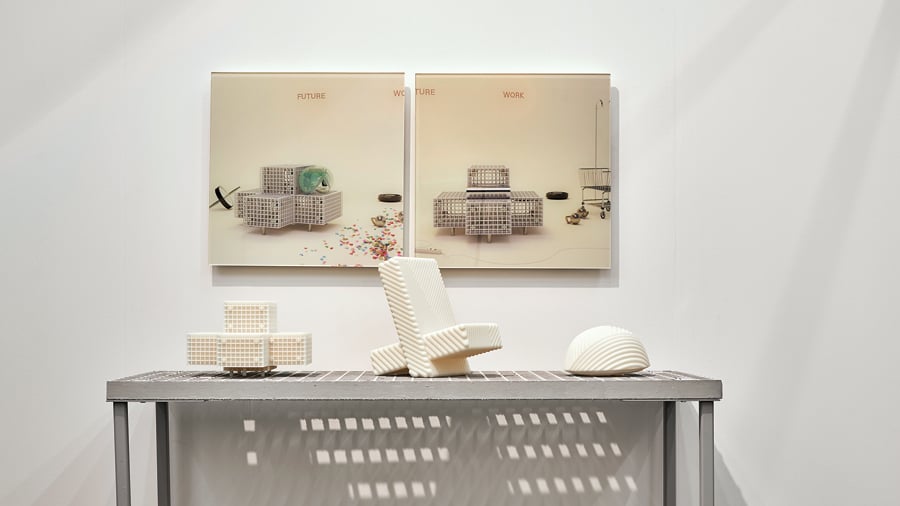
June 5, 2017
What Will Offices Look Like in the “Post-Work” Environment?
What will the workplace be once automation takes over? SO-IL principal Florian Idenburg, who has just co-created a Future Work series for Knoll, speculates.
For professionals who reflexively pride themselves on their masochistic, Protestant, and self-negating attitude toward working hours, architects have a particularly confused relationship with the place where this work happens. What else are we to make of the repetitive and uninspiring office landscapes they churn out? Designing imaginative workplaces conducive to healthy organizations for life and work seems beyond them. Have they—we—simply given up on the typology?
If so, this abdication is strange, as workplace design is an incredibly active field. Advances in technology and ever-increasing real estate costs have triggered tremendous shifts in the physical, socioeconomic, and cultural spheres of contemporary life. The capricious velocity of this dynamic has left the slow-moving profession of architecture struggling to keep up. Whereas Frank Lloyd Wright designed pretty much everything at the SC Johnson headquarters (1939), down to employee work desks, Frank Gehry gave Facebook a new campus (2015) that is not much more than a vast shed with a general floor plan.
Maybe it’s more lack of interest, which can be traced to the assumption that this area of design will soon be left to robotic engineers and production-plant designers. According to a 2013 University of Oxford study, 47 percent of the world’s jobs are set to be automated in the next two decades. (Follow-up reports have disputed that figure, but a significant percentage of office jobs are on their way to automation.) The world’s largest hedge fund, Bridgewater Associates, has a team of engineers working on a project to replace managers with artificial intelligence in order to automate decision making; the measure will ostensibly save time and eliminate human emotional volatility. As robots assume a more prominent position within the economic equations of capitalism, the workplace itself may be freed from having to participate in this calculation. In other words, once all (or most) office work is done by machines, the office worker, and therefore the architect, can begin to focus on other activities.
This hope derives, in part, from the concept of universal basic income (UBI), a subject of much heated debate. In short, UBI would provide every member of a society with basic means of subsistence. If leveraged with additional state provisions, its implementation would free us from menial labor and so refocus our brainpower and energy to pursue and indulge different types of fulfillment. Already, emerging ideas of “playbor” and “enterprise gamification” and even tired ones (“hackathons”) suggest a general “ludification” of work, the merging of leisure and obligation. Office work is beginning to turn into an activity that offers a sense of belonging and validation, and the workplace will be primarily shaped by new cultural attitudes that will arise with the diminishment of labor’s role in our lives.
Work clubs, membership-based innovation labs, venture cafés, industry conferences—all these spaces offer a glimpse into a “postwork” landscape that became the focus of a series of studios I taught at the Harvard Graduate School of Design. With the aid of the young designer Duncan Scovil and the support of Benjamin Pardo, executive vice president and design director at Knoll, the studios were framed as an attempt to apply architectural intelligence (in the form of research and speculative design) to the problem of the changing office. Ultimately, we examined three conditions. The first studio, “Campus and Event,” looked at the seeming contradiction between the nomadic tech worker—for whom the time and place of work is limitless—and the boom in bespoke and heavily surveilled tech campuses. “Glass Works” dove into the proliferation of innovation labs and contrasted these R&D incubators with Corning, an unfazeable corporation with a track record of centuries of “disruption.” The final studio, “Space Work,” examined the government in operation, specifically NASA and how its model of innovation through “the mission” compares with private-sector techniques of permanent troubleshooting. Altogether, this research generated not only a broad overview of remarkable architectural precedents in the U.S. but also a number of speculative, often dystopian scenarios of where the workplace is heading.
On a more direct level, SO-IL, the architecture firm I lead with Jing Liu and Ilias Papageorgiou, has collaborated with Knoll on a suite of hybrid objects that anticipate, in a provocative way, the “post-work” environment described above. The three pieces we developed for the Future Work series have no predefined orientation and function, and they are designed to be used not for long hours on end but, instead, short bursts of work. They can be used by one person or several at the same time, as they move from one productive distraction to the next.
In these ways the Future Work “equipment” is the opposite of the Aeron chair and its enshrinement of ergonomics, which can be seen as a final effort to squeeze the last “juice” out of a worker by maximizing sitting time. Comparatively, the Future Work objects are a sort of CrossFit ensemble for the workspace; just as CrossFit brought the street into the gym (or vice versa), Future Work brings life (and lifestyle) into the office. As one uses these objects, one becomes more fit and invigorated precisely because they require interpretation and physical manipulation. The pieces and the scenarios we imagine for them augur an even more diffuse world of labor, capital, and style. As for the robots, they’ll be around, patiently helping us rearrange and optimize our world.
If you enjoyed this article, you may enjoy reading about SO-IL’s foray into museum design, in “Post-Recession, A Generation of Architects (Finally) Gets Its Chance.“
Recent Viewpoints
Viewpoints
Google’s Ivy Ross Makes Sense of Color














